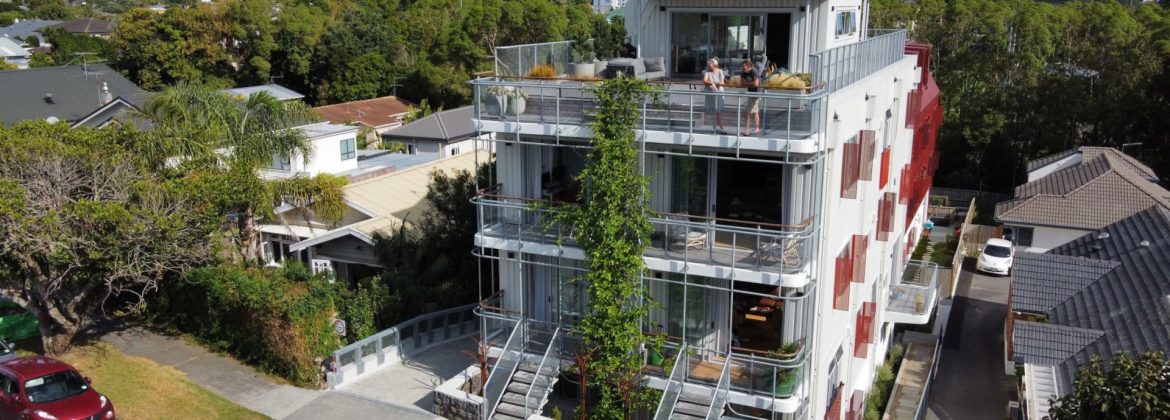New Zealand Green Building Council
A Green Future for Infrastructure.
The days of fossil fuel uses in commercial buildings are long gone. As catastrophic and extreme climate events continue to increase in frequency and intensity across the globe, it has become crystal clear that we must build consciously for our future generations and planet.
The built environment, including infrastructure, accounts for over 20% of emissions here in Aotearoa New Zealand. Fossil fuel use in buildings is a big part of the issue, contributing 1.59 Mt CO2-equivalent per year according to the Ministry for the Environment– equivalent to over half a million passenger cars on New Zealand’s roads.
Consumers are increasingly demanding green practices from the sector, and the market must shift in response. In New Zealand, there is growing pressure to consider the likes of energy use, embodied carbon, and circular economies, as we witness a collective realisation that sustainability is critical in business, property, and development. Here at the New Zealand Green Building Council (NZGBC) we work alongside the property and construction sectors to set standards for a sustainable built environment, ensuring we are taking care of future generations.
The NZGBC is a for-purpose led industry body driving for all homes and buildings to be green and sustainable for healthier, happier New Zealanders. Over 700 members from a diverse range of organisations including government departments, banks, energy companies, and insurers, to property and construction companies, architects, developers, designers and tertiary education providers.
 A collective and government-level shift.
A collective and government-level shift.
“Having a pathway to decarbonise is increasingly being demanded by investors, employees, tenants and consumers. Those who don’t risk being left behind with stranded assets. We’re also increasingly seeing electrification as a pathway to accessing sustainable finance,” says Andrew Eagles NZGBC Chief Executive.
This growing call for greener futures has influenced change at a government level, with recent changes announcement to New Zealand’s primary building legislation – the Building Act, aimed at lowering emissions and reducing waste. While already common among many OECD countries, New Zealand is finally considering mandatory energy performance ratings for buildings, as well as waste minimisation plans for construction and demolition projects.
When making the announcement, the Minister for Building and Construction Megan Woods said we know to expect more severe weather events that will impact tenants and building owners.
“These proposals provide a clear signal that considering climate resilience, and the emissions impact of our buildings is a core responsibility of the sector,” she said at the time.
The announcement aligns with the New Zealand government’s Emissions Reduction Plan, as well as our independent Climate Change Commission’s recommendations for government to put in place measures such as mandatory energy performance programmes to embed measurement and benchmarking.
“The most sustainable building is one that is already built, so the emphasis must be to get the best possible use out of it, and ensure the systems, procurement, and technology is in place to ensure it performs in a way fit for a low-carbon future.”
Following in the footsteps of Australia’s energy benchmarking tool NABERS, the New Zealand government has licensed the tool for use here. NABERSNZ is currently in over 130 offices to measure and benchmark energy performance. Businesses are already taking the initiative and using the likes of NABERSNZ and Green Star Performance to take stock of operational performance and make improvements. Government procurement rules have also helped improve uptake, with government departments required to meet NABERSNZ rating requirements.
This procurement guidance has also flowed into new build requirements, with commercial sustainability tool Green Star now compulsory for new government department buildings. “For those building new buildings worth over $9m, we must look at the entire lifecycle of a building, from its inception to intended use – trying to reduce typically high-pollutant activities in the construction process. For example, importing building materials from overseas at a high carbon-footprint cost, using fossil fuels or natural gases instead of clean electricity, promoting occupants to use vehicles instead of public or more sustainable means of transport.”
While we’d like these certifications to be redundant, the reality is that until our building regulations require healthy, sustainable building, we must continue to rely on our sector to show leadership and step up to the mark. Certifications like Green Star and NABERSNZ provide a framework for things like reducing waste, energy and water consumption. In the last year we’ve released key guidance for the sector and an embodied carbon calculator to help the industry understand and tackle emissions associated with materials and products. We’re observing a huge interest in measuring and reducing these emissions. There is also an increasing interest in reducing waste to landfill and improving circularity.
 The reality of a changing climate is starting to hit.
The reality of a changing climate is starting to hit.
With the impacts of climate change already evident, there can be little question as to why we’re seeing growing demand and action when it comes to sustainable buildings. New Zealand has experienced very abnormal weather patterns in the past few years that have adversely impacted many communities, from catastrophic flooding in our largest city; Auckland, to Cyclone Gabriel wreaking havoc on much of the North Island. Across the globe we are witnessing heatwaves, unprecedented storms and raging bush fires in the likes of Greece and California, displacing people and signalling that the mercury is truly rising.
Four global climate records have been broken that truly demonstrate the tangibility of climate change – the hottest day on record, the hottest June, extreme marine heatwaves (with ocean temperatures up to 5 degrees Celsius warmer) and record low Antarctic Sea ice. When you face these facts it’s obvious why we are witnessing a collective shift in the way we approach sustainability – but as with any industry precedent, there is an economic benefit too.
The risks associated with the changing climate present a challenge for companies and their directors. Here in New Zealand, the government has mandated 200 entities to produce climate related disclosures in line with the recommendations of the Task Force of Climate-related Financial Disclosures (TFCD). all registered banks, credit unions, building societies, licensed insurers, and investment schemes with assets of more than $1 billion, quoted equity securities with a combined market price exceeding $60 million and quoted debt securities with a combined face value of quoted debt exceeding $60 million.
For the first time, companies must consider how their governance, strategy, risk management, and metrics and targets relate to climate change. Climate change, resilience, and the realities of a zero carbon future are being embedded into board room decisions. Considering risk, and meeting Environmental, Social, and Governance (ESG) principles are becoming the new norm. Green credentials and benchmarking provide ready-made ways of reporting environmental progress and impact.
Economic benefits.
Not only does building with a green mindset satisfy consumers and help mitigate climate change – it is good for business. There are very clear and growing demands from consumers, investors, and regulators to reduce and report on emission which impact a multitude of sectors.
We see reduced operating costs, happier and more productive occupants, higher occupancy rates, and enhanced asset value and profitability associated with green buildings. People want to work in an intentional, innovative environment, so it makes sense that green buildings foster community, industry and collaboration. Green buildings have a pivotal part to play in a post-Covid remote work era where businesses are struggling to get employees back in the office. The market is pivoting to realize that building with intention is the way to go.
“Businesses have an opportunity to show leadership and demonstrate their environmental credentials. We can do better. It is what consumers want, it is what investors want and what regulators are increasingly requiring of us, and most importantly, the future of our planet demands we act.”
AT A GLANCE
New Zealand Green Building Council
What: A council representing over 700 organisations and companies who believe in a better built Aotearoa. They advocate for regulatory and industry-wide change, provide independent and trusted certification, and support New Zealand on its path to a low carbon future.
Where: Auckland, New Zealand
Website: https://www.nzgbc.org.nz/



 This information will never be shared to third parties
This information will never be shared to third parties